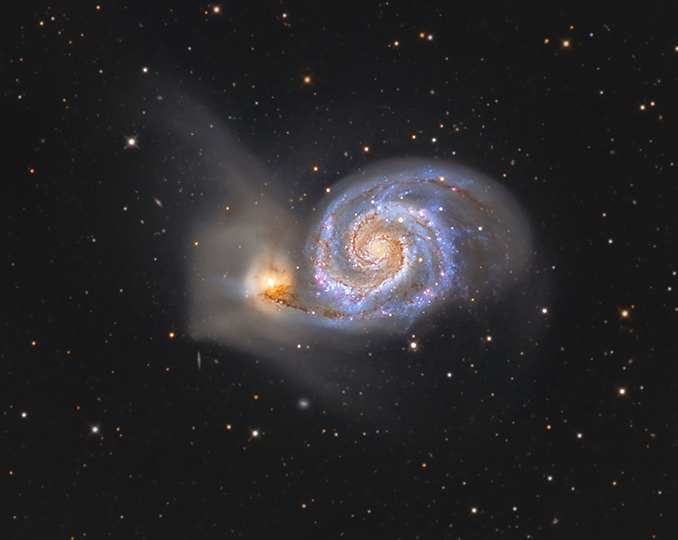



| Observer: | Tom Campbell |
| Location: | Iola, Kansas (Long: 95°24'W Lat: 37°55'N) |
| Equipment: | 8" Discovery DHQ dob |
| Eyepieces: | 1.25" Plössls - 25mm (49x), 15mm (81x), 10mm (122x), 6.5mm (188x) |
| Time: | 9:30pm - 10:30pm CST (02:30-03:30 UT) |
| Transparency: | Clear (8/10) |
| Seeing: | Mostly Stable (7/10) |
| Weather: | Temperatures in the low 60s, dropping as the evening progressed. There was no breeze. |

After reviewing my notes for the last couple of years, I discovered that I only needed to observe one more Messier object to complete the list - M83. It is low in the Southern sky, but I hoped I could catch it while the Moon was nearly new. I set up before sunset in order to allow my telescope to have plenty of cooldown time.
| M 83 | Hydra | Spiral Galaxy | 9:40pm CDT |
| NGC 5236 | RA: 1337.0 | Dec: -2952 | Mag: 7.6 |
 |
This galaxy is low in the sky right now, and it is difficult to get a decent view. In order to see it at all, I had to move my telescope out into a heavily light-polluted section of my yard. The best view was at 122x. The core was stellar with a surrounding fuzzy patch of light. The arms of the spiral galaxy appear larger with averted vision, but the shape is still difficult to discern. |
||
| M 104 (Sombrero) | Virgo | Spiral Galaxy | 9:45pm CDT |
| NGC 4594 | RA: 1240.0 | Dec: -1137 | Mag: 8.3 |
 |
I always like to look at this galaxy. In fact, even though it is officially in Virgo, whenever I see Corvus in the sky, I think of the Sombrero. The galaxy is elongated and cigar-shaped, with a stellar core. The dark dust lane could be easily detected tonight, with just a hint of the rest of the galaxy on the other side of the band. Some nearby field stars are slightly brighter than the Sombrero's core, and are a little distracting, but at least they help me to make sure I'm at perfect focus. Besides the stellar portion of the core, you can see a sudden decrease in brightness about halfway out, indicating where the spiral arms begin. The best view was at 122x. Finding this galaxy is pretty easy. Once you get in the general area, a Sagitta-shaped asterism of fairly bright stars point almost directly at the Sombrero, which is in the same field at low power. |
||
| Ringtail/Antennae | Corvus | Interacting Galaxies | 10:00pm CDT |
| NGC 4038/4039 | RA: 1201.9 | Dec: -1853 | Mag: 10.9, 11.2 |
 |
These galaxies are just barely detectable in my 8". They appear as a faint smudge of light. The exact shape couldn't even be determined. A distracting bright star lies nearby, providing a much-needed focusing aid. I've seen this pair in a 20" Starmaster, and the heart-shaped double core was plainly visible, as was one of the antennae. In my 8", I'm happy to be able to detect it at all, especially in as poor of skies as I have for galaxy-observing. |
||
| NGC 4361 | Corvus | Planetary Nebula | 10:05pm CDT |
| RA: 1224.5 | Dec: -1847 | Mag: 10.3, 13.2 | |
 |
The central star is detectable in this planetary, even at 49x. The O-III filter doesn't really increase the brightness of the nebula, but it does help to define the borders. It appears to be somewhat oval in shape. I prefer the unfiltered view on this one, especially at higher powers. |
||
| M 51 (Whirlpool) | Canes Venatici | Interacting Galaxies | 10:15pm CDT |
| NGC 5194/5195 | RA: 1329.8 | Dec: +4714 | Mag: 9.0, 10.5 |
 |
This is beautiful tonight. The cores are bright and easily discerned. The center of each core is stellar. With averted vision at 81x, hints of spiral structure can be seen in the large galaxy. |
||
The telescope was beginning to dew up badly, affecting my observing. I had nabbed what I was after tonight, so I didn't feel too bad about cutting the session short.